I have the results of a simulation that involved removing data and refitting a model, and generated the mean and CIs for 5 beta coefficients (AAA:EEE). The sample data are reproducible through dupt().
data <- structure(list(PercentData = structure(c(1L, 1L, 1L, 1L, 1L, 2L, 2L, 2L, 2L, 2L, 3L, 3L, 3L, 3L, 3L), .Label = c("90Percent", "80Percent", "70Percent", "60Percent", "50Percent", "40Percent", "30Percent", "20Percent"), class = "factor"), Beta = c("AAA", "BBB", "CCC", "DDD", "EEE", "AAA", "BBB", "CCC", "DDD", "EEE", "AAA", "BBB", "CCC", "DDD", "EEE"), Mean = c(-0.0184798128725727, 0.577389832570274, 0.307079889066798, -1.04434737355186, 0.765444299971639, -0.0342811658086197, 0.571119844203796, 0.307904693724208, -1.05833526491829, 0.772586633692223, -0.0287982339992084, 0.567559187110271, 0.300408471488675, -1.05392763762688, 0.768956684863523), UpperCI = c(0.011382484714714, 0.592146704143253, 0.334772268551607, -0.997865978815953, 0.787196643647358, 0.0270716705899447, 0.595047291677895, 0.363220155550484, -1.01101175408862, 0.82142109640807, 0.0501543137571774, 0.597455743424951, 0.351903162023205, -1.00408187639287, 0.805740012899328), LowerCI = c(-0.0483421104598594, 0.562632960997295, 0.279387509581988, -1.09082876828776, 0.743691956295919, -0.0956340022071842, 0.547192396729696, 0.252589231897933, -1.10565877574796, 0.723752170976376, -0.107750781755594, 0.537662630795591, 0.248913780954145, -1.10377339886088, 0.732173356827717)), .Names = c("PercentData", "Beta", "Mean", "UpperCI", "LowerCI"), row.names = c("X1", "X2", "X3", "X4", "X5", "X1.1", "X2.1", "X3.1", "X4.1", "X5.1", "X1.2", "X2.2", "X3.2", "X4.2", "X5.2"), class = "data.frame")
head(data)
# PercentData Beta Mean UpperCI LowerCI
# X1 90Percent AAA -0.01847981 0.01138248 -0.04834211
# X2 90Percent BBB 0.57738983 0.59214670 0.56263296
# X3 90Percent CCC 0.30707989 0.33477227 0.27938751
# X4 90Percent DDD -1.04434737 -0.99786598 -1.09082877
# X5 90Percent EEE 0.76544430 0.78719664 0.74369196
# X1.1 80Percent AAA -0.03428117 0.02707167 -0.09563400
I can plot the simulation data using this code
require(ggplot2)
ggplot(data, aes(x = Beta)) +
geom_point(aes(y = Mean, color = PercentData),
position = position_dodge(0.5),
size=2.5) +
geom_errorbar(aes(ymin = LowerCI,
ymax = UpperCI,
color = PercentData),
cex = 1.25,
width = .75,
position = position_dodge(0.5))

I want to add the "truth" to the above figure. Currently, I have the truth data in a different DF, which is below.
truth <- structure(list(Est = c(-0.0178489366139546, 0.575347417798796, 0.299445933484525, -1.02862600141036, 0.767365594695577), UpperCI = c(0.486793276079609, 0.647987076085212, 0.380433141441644, -0.937511307956846, 0.837682594951183 ), LowerCI = c(-0.522491149307518, 0.502707759512379, 0.218458725527406, -1.11974069486387, 0.697048594439971), Beta = c("AAA", "BBB", "CCC", "DDD", "EEE")), .Names = c("Est", "UpperCI", "LowerCI", "Beta"), row.names = c(NA, 5L), class = "data.frame")
head(truth)
# Est UpperCI LowerCI Beta
# 1 -0.01784894 0.4867933 -0.5224911 AAA
# 2 0.57534742 0.6479871 0.5027078 BBB
# 3 0.29944593 0.3804331 0.2184587 CCC
# 4 -1.02862600 -0.9375113 -1.1197407 DDD
# 5 0.76736559 0.8376826 0.6970486 EEE
I would like to add the truth data as a line to the above figure and have provided a schematic below where the added black lines are the truth$Est values - although they are not drawn to represent the actual values.
If possible, it would be nice to also include the truth Upper and Lower CIs. Is it possible to draw two lines - one at each CI value?

I have left the truth data as a separate DF as I am not sure on the best way to format the data for the intended result. I can reformat based on comments or suggestions to have the data in a single melt() data frame.
Thanks in advance.
